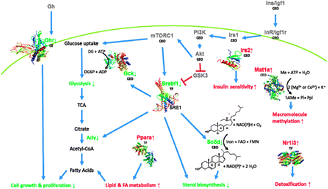A meta-analysis of caloric restriction gene expression profiles to infer common signatures and regulatory mechanisms†
Abstract
Caloric restriction, a reduction in calorie intake without malnutrition, retards age-related degeneration and extends lifespan in several organisms. CR induces multiple changes, yet its underlying mechanisms remain poorly understood. In this work, we first performed a meta-analysis of microarray CR studies in mammals and identified genes and processes robustly altered due to CR. Our results reveal a complex array of CR-induced changes and we re-identified several genes and processes previously associated with CR, such as growth hormone signalling, lipid metabolism and immune response. Moreover, our results highlight novel associations with CR, such as retinol metabolism and copper ion detoxification, as well as hint of a strong effect of CR on circadian rhythms that in turn may contribute to metabolic changes. Analyses of our signatures by integrating co-expression data, information on genetic mutants, and transcription factor binding site analysis revealed candidate regulators of transcriptional modules in CR. Our results hint at a transcriptional module involved in sterol metabolism regulated by Srebf1. A putative regulatory role of Ppara was also identified. Overall, our conserved molecular signatures of CR provide a comprehensive picture of CR-induced changes and help understand its regulatory mechanisms.


 Please wait while we load your content...
Please wait while we load your content...